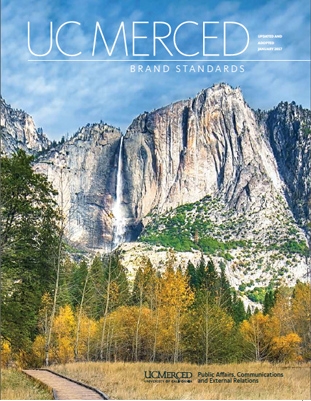University Communications Unveils Brand Standards, Responsive Web Template
 University Communications has updated the campus’s brand standards, which provide a strong visual link from our university environment to our brand identity across the wide range of applications in use.
University Communications has updated the campus’s brand standards, which provide a strong visual link from our university environment to our brand identity across the wide range of applications in use.
“As UC Merced continues to grow and its reputation expands beyond the Central Valley, it is critical for us to adhere to these standards in order to maintain a cohesive look and feel across our work during this very exciting time,” said Associate Chancellor and Chief of Staff Ed Klotzbier. “A consistent brand helps define and reinforce who we are as an institution and further promotes our academic distinction, research excellence and the success of our students.”
Among the highlights in the revised Brand Standards:
- The colors in these new standards were carefully chosen based on UC Merced’s rich physical environment and inspired by the critical research and teaching the university delivers to its diverse student population. Users can learn more about the award-winning palette and each color’s special narrative.
- The standards contain information about new logo formats and the process for requesting new departmental logos.
- A new UC Merced seal has been developed, and directions on its use are listed in detail.
- Campus signage and social media policies have been added to the standards and cover requirements regarding the proper use of the university’s name, logo, seal, colors and approved fonts.
- Business card layouts have been refreshed and offer two variations.
- The front and back covers of the Brand Standards feature photography by UC Merced Chancellor Dorothy, taken at Yosemite National Park.
- The California Foundation Seed Program provided special approval in naming our Merced Rye Green, a seed native to this region.
Web Team Releases New Responsive Web Template
University Communications also announced the release of Yosemite, a new responsive website template that is available in three options: full slider, three-quarter slider and new side navigation. 
One key feature of the new template is it allows news from the gateway website and events pulled from the events calendar website to be imported to secondary websites. Website owners can ask for this feature when they submit their migration request.
“This new feature helps keep website content fresh while removing duplication efforts,” Web Communications Manager Amy Lozano-Smith said.
The web team is also plans to import faculty profiles from the gateway site in the coming months; follow-up information will be sent when available.
This new, responsive template is the only approved template for UC Merced departments and academic programs and is available at no charge. Web Communications manages the Drupal platform, reviews new modules for enhanced features and performs system updates, and develops special features that help customize users’ content if needed. Web Communications chose the Office of the Chancellor, Merced 2020 Project and Health Sciences Research Institute websites to undergo early migration to test the process.
In addition to being responsive, the new template design meets Web Content Accessibility Guidelines’ AA rating, meaning the design meets the required level of accessibility for users that employ assistive technology devices when using the web. Website owners are required to keep their content accessible, such as properly using alt-text descriptions for images and creating web pages or webforms in lieu of PDFs when possible. PDFs should be optimized for accessibility when used on websites. These items will be discussed in detail with site owners before they migrate their websites.
Site owners remain responsible for developing their content and maintaining its accuracy and accessibility standards.
Web Communications describes the migration processes as follows:
First steps: Prior to requesting migration, site owners should review the following Website Development Checklist. This covers tasks for a smooth migration and search engine optimization tips.
The migration timeline depends on how much time clients can dedicate to the process. It can take up to three to four weeks depending on website’s size and preparedness. Web Communications recommends finding a time — after completing the above web checklist — when the live site is not actively updated.
Cloning your live website: Once we clone your website to our development servers, Web Communications will lock down your live site so that edits are not accidentally implemented. During this stage, any edits made to the live site will not be reflected on your development site.
After we implement Yosemite onto your site and set up the template, Web Communications will turn over the site for owner’s review and final edits. This is when new panoramic slider photos can be added and any other finessing can be done, once site owners see the site in its new format.
Site review: After site owners complete their editing, they will notify Lozano-Smith, and a technical review will be scheduled prior to launch. Sites will also undergo a content review after the technical review. Site owners should build one week into the launch schedule for this stage.
Launch: Now it’s time to deploy the new site on the production servers. This process is very quick once initiated and in a short time, the new site will populate the web.
Resources:
- Download a copy of the Brand Standards from the University Communications website or review online.
- To review and request website migration, please begin with the checklist. You may then request migration.
- General questions regarding the UC Merced Brand Standards can be directed to Jennifer Biancucci.
- Send website migration and development inquiries to Amy Lozano-Smith.
- Direct social media inquiries to Tonya Kubo.
